自我效能感-文献综述
- 格式:docx
- 大小:27.85 KB
- 文档页数:9

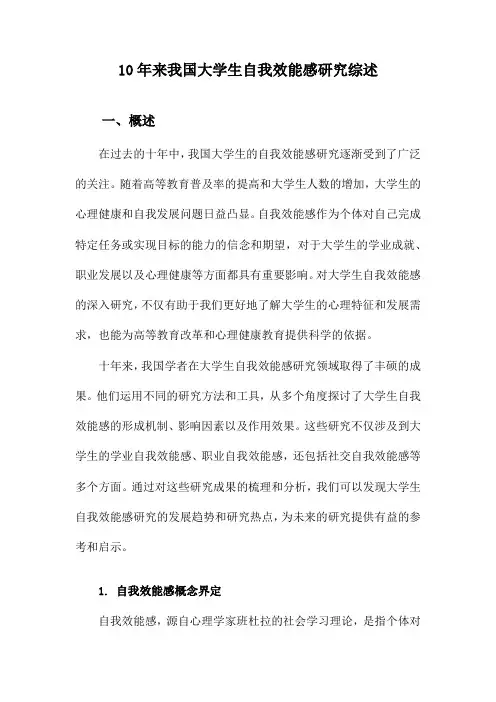
10年来我国大学生自我效能感研究综述一、概述在过去的十年中,我国大学生的自我效能感研究逐渐受到了广泛的关注。
随着高等教育普及率的提高和大学生人数的增加,大学生的心理健康和自我发展问题日益凸显。
自我效能感作为个体对自己完成特定任务或实现目标的能力的信念和期望,对于大学生的学业成就、职业发展以及心理健康等方面都具有重要影响。
对大学生自我效能感的深入研究,不仅有助于我们更好地了解大学生的心理特征和发展需求,也能为高等教育改革和心理健康教育提供科学的依据。
十年来,我国学者在大学生自我效能感研究领域取得了丰硕的成果。
他们运用不同的研究方法和工具,从多个角度探讨了大学生自我效能感的形成机制、影响因素以及作用效果。
这些研究不仅涉及到大学生的学业自我效能感、职业自我效能感,还包括社交自我效能感等多个方面。
通过对这些研究成果的梳理和分析,我们可以发现大学生自我效能感研究的发展趋势和研究热点,为未来的研究提供有益的参考和启示。
1. 自我效能感概念界定自我效能感,源自心理学家班杜拉的社会学习理论,是指个体对自己完成特定任务或达到某个目标的能力的信念和期望。
在学术研究中,自我效能感被看作是个体动机、行为和成就的重要中介变量。
这一概念自提出以来,在教育、职业、心理健康等多个领域得到了广泛关注和应用。
特别是在高等教育领域,大学生的自我效能感对其学业成就、职业发展乃至整体心理健康的影响日益受到研究者的重视。
对于大学生而言,自我效能感主要体现在他们对自己学习能力、社交能力、问题解决能力、自我管理能力等多方面的评价和信心。
这些评价不仅影响着大学生在学习、生活和未来职业发展中的选择和努力程度,也关系到他们面对挑战时的心理适应和应对策略。
深入研究和理解大学生自我效能感的概念内涵、形成机制及其影响因素,对于促进大学生的全面发展和提高教育质量具有重要意义。
在过去的十年中,我国学者在大学生自我效能感的研究方面取得了丰富的成果。
这些研究不仅探讨了大学生自我效能感的内涵和结构,还分析了其影响因素和作用机制,为提升大学生的自我效能感提供了理论支持和实践指导。

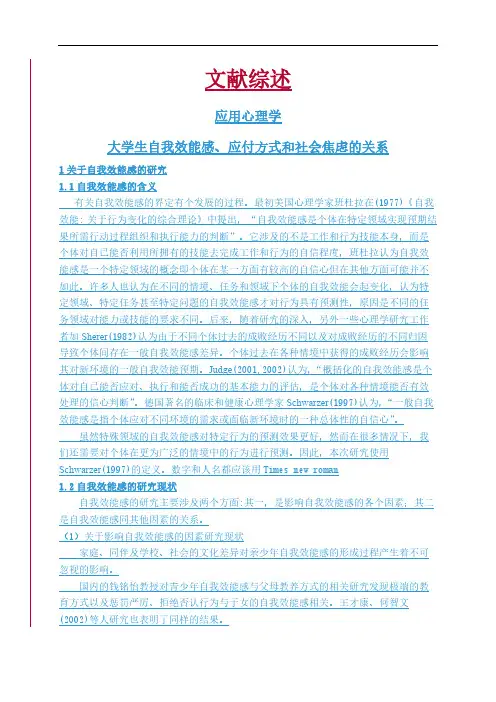
文献综述应用心理学大学生自我效能感、应付方式和社会焦虑的关系1关于自我效能感的研究1.1自我效能感的含义有关自我效能感的界定有个发展的过程。
最初美国心理学家班杜拉在(1977)《自我效能: 关于行为变化的综合理论》中提出,“自我效能感是个体在特定领域实现预期结果所需行动过程组织和执行能力的判断”。
它涉及的不是工作和行为技能本身,而是个体对自己能否利用所拥有的技能去完成工作和行为的自信程度,班杜拉认为自我效能感是一个特定领域的概念即个体在某一方面有较高的自信心但在其他方面可能并不如此。
许多人也认为在不同的情境、任务和领域下个体的自我效能会起变化,认为特定领域、特定任务甚至特定问题的自我效能感才对行为具有预测性,原因是不同的任务领域对能力或技能的要求不同。
后来,随着研究的深入,另外一些心理学研究工作者如Sherer(1982)认为由于不同个体过去的成败经历不同以及对成败经历的不同归因导致个体间存在一般自我效能感差异。
个体过去在各种情境中获得的成败经历会影响其对新环境的一般自我效能预期。
Judge(2001,2002)认为,“概括化的自我效能感是个体对自己能否应对、执行和能否成功的基本能力的评估,是个体对各种情境能否有效处理的信心判断”。
德国著名的临床和健康心理学家Schwarzer(1997)认为,“一般自我效能感是指个体应对不同环境的需求或面临新环境时的一种总体性的自信心”。
虽然特殊领域的自我效能感对特定行为的预测效果更好,然而在很多情况下,我们还需要对个体在更为广泛的情境中的行为进行预测。
因此,本次研究使用Schwarzer(1997)的定义。
数字和人名都应该用Times new roman1.2自我效能感的研究现状自我效能感的研究主要涉及两个方面:其一,是影响自我效能感的各个因素;其二是自我效能感同其他因素的关系。
(1)关于影响自我效能感的因素研究现状家庭、同伴及学校、社会的文化差异对亲少年自我效能感的形成过程产生着不可忽视的影响。
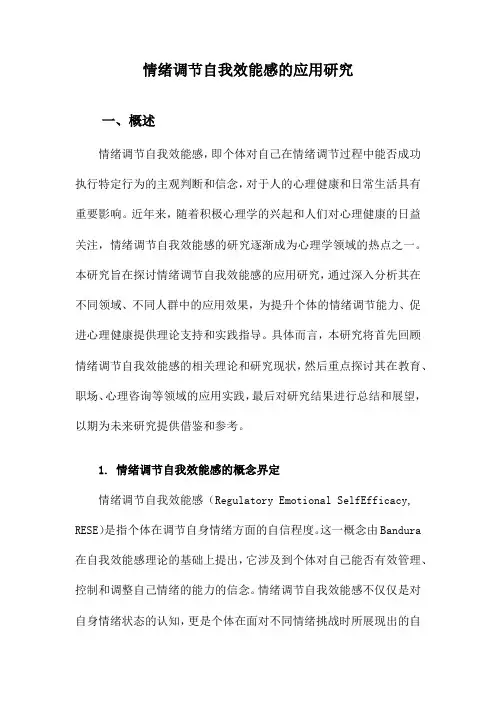
情绪调节自我效能感的应用研究一、概述情绪调节自我效能感,即个体对自己在情绪调节过程中能否成功执行特定行为的主观判断和信念,对于人的心理健康和日常生活具有重要影响。
近年来,随着积极心理学的兴起和人们对心理健康的日益关注,情绪调节自我效能感的研究逐渐成为心理学领域的热点之一。
本研究旨在探讨情绪调节自我效能感的应用研究,通过深入分析其在不同领域、不同人群中的应用效果,为提升个体的情绪调节能力、促进心理健康提供理论支持和实践指导。
具体而言,本研究将首先回顾情绪调节自我效能感的相关理论和研究现状,然后重点探讨其在教育、职场、心理咨询等领域的应用实践,最后对研究结果进行总结和展望,以期为未来研究提供借鉴和参考。
1. 情绪调节自我效能感的概念界定情绪调节自我效能感(Regulatory Emotional SelfEfficacy, RESE)是指个体在调节自身情绪方面的自信程度。
这一概念由Bandura 在自我效能感理论的基础上提出,它涉及到个体对自己能否有效管理、控制和调整自己情绪的能力的信念。
情绪调节自我效能感不仅仅是对自身情绪状态的认知,更是个体在面对不同情绪挑战时所展现出的自信和行动倾向。
情绪调节自我效能感包括认知重评和表达抑制两个方面。
认知重评是指个体在面对情绪刺激时,能够主动调整自己的认知评价,从而改变情绪反应的性质和强度。
表达抑制则是指个体通过抑制情绪表达行为来管理情绪,避免情绪的外显化。
这两种情绪调节策略在个体应对压力、挫折和日常生活中的各种情绪挑战时都起着重要作用。
情绪调节自我效能感对个体的心理健康和社会适应具有重要影响。
高情绪调节自我效能感的个体能够更好地应对生活中的情绪挑战,减少情绪困扰,提高心理健康水平。
同时,他们也更有可能在社交场合中表现出自信、积极和适应性强的特点,从而建立良好的人际关系,提高社会适应能力。
对情绪调节自我效能感的研究不仅有助于我们理解个体情绪调节的内在机制,还为心理健康教育和临床心理治疗提供了重要的理论依据和实践指导。
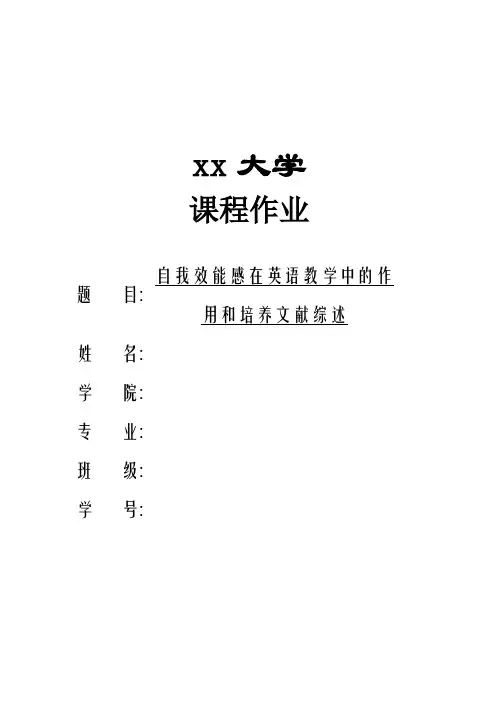
xx大学课程作业题目: 自我效能感在英语教学中的作用和培养文献综述姓名: 学院: 专业: 班级: 学号:自我效能感在英语教学中的作用和培养文献综述一、前言自我效能感理论对于自我控制和调节具有重要作用。
通过阅读大量的相关文献,笔者以自我效能感在英语教学中的作用和培养作为切入点,在本文中阐述了自我效能感理论的界定、形成因素、作用、以及自我效能感在英语教学领域最新进展,包括对学生学业成绩的影响、对学生成就动机的影响以及对教师教学行为与教师自身信念的影响。
通过对自我效能感理论在英语教学领域的现状分析,可以看出我国相关研究取得的成就以及不足之处,本文力求以新的视角来对该理论进行文献综述,取得一定的创新与发展。
二、自我效能感的界定及其形成因素1.“自我效能感”的概念这一理论最早是由班杜拉1977年首次提出的。
班杜拉将其界定为“人们对自己实现特定领域行为目标所需能力的信心或信念,是特定领域的概念。
自我效能感不是一种技能,也不是一个人的真实能力,而是个体对完成特定任务所具有的行为能力的自信程度。
”此外,其他学者对于“自我效能感”也有不同的界定,如:“是使得个体能够有效地同周围世界打交道的一种人格”、“是个人对自己能否进行某一行为的实施能力的推测或判断,它意味着人是否确信自己能够成功的进行带来某一结果的行为。
(周国涛、戚立夫)”等。
虽然不同的学者对于自我效能感的界定不同,但是其核心思想是一致的。
2.自我效能感的形成因素123班杜拉等人的研究指出,自我效能感的形成因素有四个方面的经验:(1)直接经验:指个体得自以往实际从事同类工作任务的成败经验。
成功的经验往往会增加个体的自我效能感,而失败的经验的作用则相反。
(2)替代经验:指个体通过观察学习示范者的的行为而获得的自我效能感。
当一个人看到与自己水平差不多的示范者取得了成功,就会增强自我效能感,反之就会降低自我效能感。
1Richard I. Evans. Albert Bandura: The Man and His Ideas- A Dialogue[M].Foreword by Ernest R. Hilgard Praeger,1989.2金引丽.一般自我效能感研究综述[J]. 淮北职业技术学院学报,2014,13(2)3顾佳旎.社会自我效能感的结构、测量及其作用机制[J]. 心理科学进展,2014,22(11):1791——1800(3)言语的指导作用:即通过他人的说服性的建议、劝告、解释来改变自我效能感。

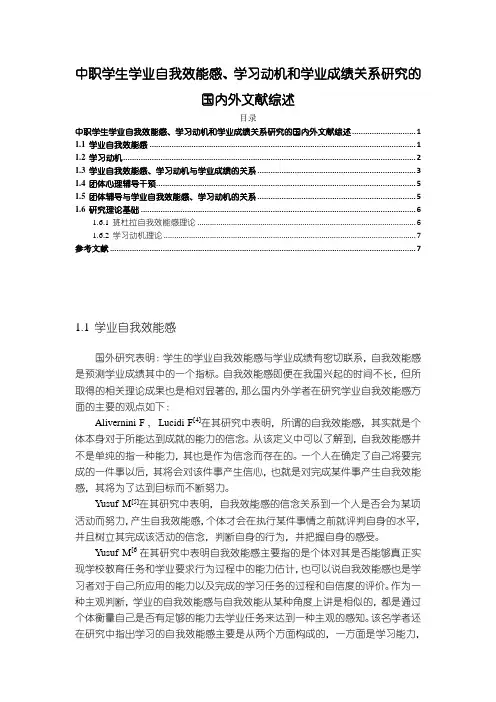
中职学生学业自我效能感、学习动机和学业成绩关系研究的国内外文献综述目录中职学生学业自我效能感、学习动机和学业成绩关系研究的国内外文献综述 (1)1.1 学业自我效能感 (1)1.2 学习动机 (2)1.3 学业自我效能感、学习动机与学业成绩的关系 (3)1.4 团体心理辅导干预 (5)1.5 团体辅导与学业自我效能感、学习动机的关系 (5)1.6 研究理论基础 (6)1.6.1 班杜拉自我效能感理论 (6)1.6.2 学习动机理论 (7)参考文献 (7)1.1 学业自我效能感国外研究表明:学生的学业自我效能感与学业成绩有密切联系,自我效能感是预测学业成绩其中的一个指标。
自我效能感即便在我国兴起的时间不长,但所取得的相关理论成果也是相对显著的,那么国内外学者在研究学业自我效能感方面的主要的观点如下:Alivernini F , Lucidi F[4]在其研究中表明,所谓的自我效能感,其实就是个体本身对于所能达到成就的能力的信念。
从该定义中可以了解到,自我效能感并不是单纯的指一种能力,其也是作为信念而存在的。
一个人在确定了自己将要完成的一件事以后,其将会对该件事产生信心,也就是对完成某件事产生自我效能感,其将为了达到目标而不断努力。
Yusuf M[5]在其研究中表明,自我效能感的信念关系到一个人是否会为某项活动而努力,产生自我效能感,个体才会在执行某件事情之前就评判自身的水平,并且树立其完成该活动的信念,判断自身的行为,并把握自身的感受。
Yusuf M[6在其研究中表明自我效能感主要指的是个体对其是否能够真正实现学校教育任务和学业要求行为过程中的能力估计,也可以说自我效能感也是学习者对于自己所应用的能力以及完成的学习任务的过程和自信度的评价。
作为一种主观判断,学业的自我效能感与自我效能从某种角度上讲是相似的,都是通过个体衡量自己是否有足够的能力去学业任务来达到一种主观的感知。
该名学者还在研究中指出学习的自我效能感主要是从两个方面构成的,一方面是学习能力,指的是在个体学业中是否能够真实有效的完成其目标,另一方面是学习能力,指的是在学业中能否真正的实现学业目标,所采取的学习方式是否能够真正的实现学业目标的心理判定与信心。
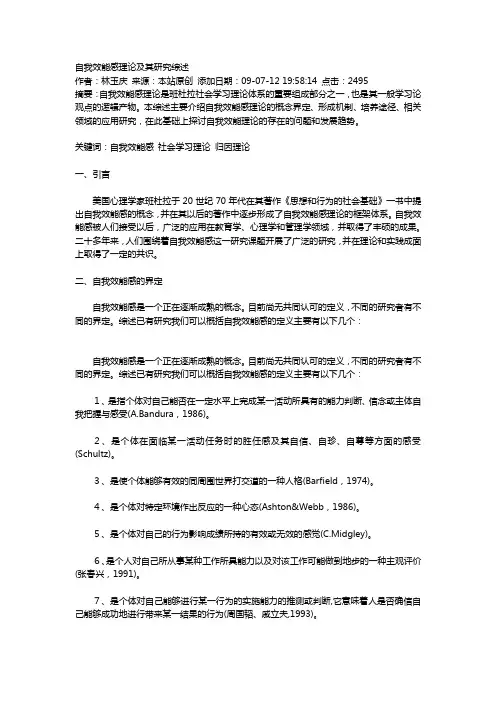
自我效能感理论及其研究综述作者:林玉庆来源:本站原创添加日期:09-07-12 19:58:14 点击:2495摘要:自我效能感理论是班杜拉社会学习理论体系的重要组成部分之一,也是其一般学习论观点的逻辑产物。
本综述主要介绍自我效能感理论的概念界定、形成机制、培养途径、相关领域的应用研究,在此基础上探讨自我效能理论的存在的问题和发展趋势。
关键词:自我效能感社会学习理论归因理论一、引言美国心理学家班杜拉于20世纪70年代在其著作《思想和行为的社会基础》一书中提出自我效能感的概念,并在其以后的著作中逐步形成了自我效能感理论的框架体系。
自我效能感被人们接受以后,广泛的应用在教育学、心理学和管理学领域,并取得了丰硕的成果。
二十多年来,人们围绕着自我效能感这一研究课题开展了广泛的研究,并在理论和实践成面上取得了一定的共识。
二、自我效能感的界定自我效能感是一个正在逐渐成熟的概念。
目前尚无共同认可的定义,不同的研究者有不同的界定。
综述已有研究我们可以概括自我效能感的定义主要有以下几个:自我效能感是一个正在逐渐成熟的概念。
目前尚无共同认可的定义,不同的研究者有不同的界定。
综述已有研究我们可以概括自我效能感的定义主要有以下几个:1、是指个体对自己能否在一定水平上完成某一活动所具有的能力判断、信念或主体自我把握与感受(A.Bandura,1986)。
2、是个体在面临某一活动任务时的胜任感及其自信、自珍、自尊等方面的感受(Schultz)。
3、是使个体能够有效的同周围世界打交道的一种人格(Barfield,1974)。
4、是个体对特定环境作出反应的一种心态(Ashton&Webb,1986)。
5、是个体对自己的行为影响成绩所持的有效或无效的感觉(C.Midgley)。
6、是个人对自己所从事某种工作所具能力以及对该工作可能做到地步的一种主观评价(张春兴,1991)。
7、是个体对自己能够进行某一行为的实施能力的推测或判断,它意味着人是否确信自己能够成功地进行带来某一结果的行为(周国韬、戚立夫,1993)。
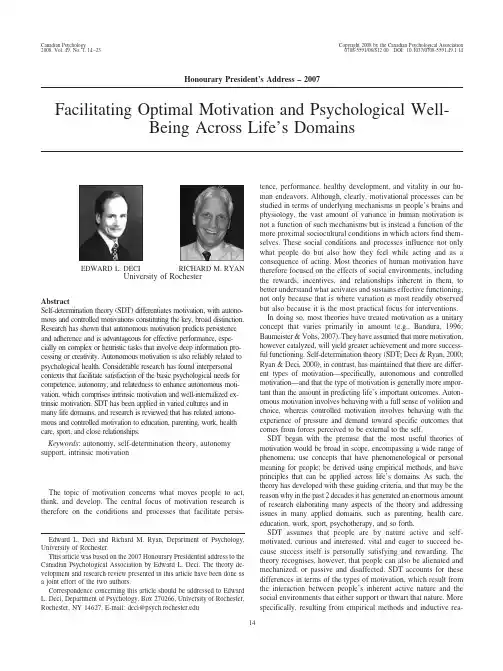
Honourary President’s Address –2007Facilitating Optimal Motivation and Psychological Well-Being Across Life’sDomainsEDWARD L.DECIRICHARD M.RYANUniversity of RochesterAbstractSelf-determination theory (SDT)differentiates motivation,with autono-mous and controlled motivations constituting the key,broad distinction.Research has shown that autonomous motivation predicts persistence and adherence and is advantageous for effective performance,espe-cially on complex or heuristic tasks that involve deep information pro-cessing or creativity.Autonomous motivation is also reliably related to psychological health.Considerable research has found interpersonal contexts that facilitate satisfaction of the basic psychological needs for competence,autonomy,and relatedness to enhance autonomous moti-vation,which comprises intrinsic motivation and well-internalized ex-trinsic motivation.SDT has been applied in varied cultures and in many life domains,and research is reviewed that has related autono-mous and controlled motivation to education,parenting,work,health care,sport,and close relationships.Keywords :autonomy,self-determination theory,autonomy support,intrinsic motivationThe topic of motivation concerns what moves people to act,think,and develop.The central focus of motivation research is therefore on the conditions and processes that facilitate persis-tence,performance,healthy development,and vitality in our hu-man endeavors.Although,clearly,motivational processes can be studied in terms of underlying mechanisms in people’s brains and physiology,the vast amount of variance in human motivation is not a function of such mechanisms but is instead a function of the more proximal sociocultural conditions in which actors find them-selves.These social conditions and processes influence not only what people do but also how they feel while acting and as a consequence of acting.Most theories of human motivation have therefore focused on the effects of social environments,including the rewards,incentives,and relationships inherent in them,to better understand what activates and sustains effective functioning,not only because that is where variation is most readily observed but also because it is the most practical focus for interventions.In doing so,most theories have treated motivation as a unitary concept that varies primarily in amount (e.g.,Bandura,1996;Baumeister &Vohs,2007).They have assumed that more motivation,however catalyzed,will yield greater achievement and more success-ful functioning.Self-determination theory (SDT;Deci &Ryan,2000;Ryan &Deci,2000),in contrast,has maintained that there are differ-ent types of motivation—specifically,autonomous and controlled motivation—and that the type of motivation is generally more impor-tant than the amount in predicting life’s important outcomes.Auton-omous motivation involves behaving with a full sense of volition and choice,whereas controlled motivation involves behaving with the experience of pressure and demand toward specific outcomes that comes from forces perceived to be external to the self.SDT began with the premise that the most useful theories of motivation would be broad in scope,encompassing a wide range of phenomena;use concepts that have phenomenological or personal meaning for people;be derived using empirical methods;and have principles that can be applied across life’s domains.As such,the theory has developed with these guiding criteria,and that may be the reason why in the past 2decades it has generated an enormous amount of research elaborating many aspects of the theory and addressing issues in many applied domains,such as parenting,health care,education,work,sport,psychotherapy,and so forth.SDT assumes that people are by nature active and self-motivated,curious and interested,vital and eager to succeed be-cause success itself is personally satisfying and rewarding.The theory recognises,however,that people can also be alienated and mechanized,or passive and disaffected.SDT accounts for these differences in terms of the types of motivation,which result from the interaction between people’s inherent active nature and the social environments that either support or thwart that nature.More specifically,resulting from empirical methods and inductive rea-Edward L.Deci and Richard M.Ryan,Department of Psychology,University of Rochester.This article was based on the 2007Honourary Presidential address to the Canadian Psychological Association by Edward L.Deci.The theory de-velopment and research review presented in this article have been done as a joint effort of the two authors.Correspondence concerning this article should be addressed to Edward L.Deci,Department of Psychology,Box 270266,University of Rochester,Rochester,NY 14627.E-mail:deci@Canadian PsychologyCopyright 2008by the Canadian Psychological Association 2008,Vol.49,No.1,14–230708-5591/08/$12.00DOI:10.1037/0708-5591.49.1.1414soning,the theory has proposed that all humans need to feel competent,autonomous,and related to others(Deci&Ryan, 2000).Social contexts that facilitate satisfaction of these three basic psychological needs will support people’s inherent activity, promote more optimal motivation,and yield the most positive psychological,developmental,and behavioural outcomes(Ryan& Deci,2000).In contrast,social environments that thwart satisfac-tion of these needs yield less optimal forms of motivation and have deleterious effects on a wide variety of well-being outcomes.SDTIn this article,we present some central components of SDT and review both basic and applied research.We begin with a discus-sion of the differentiation of motivation within the SDT tradition, which started with the distinction between intrinsic and extrinsic motivation(Deci&Ryan,1985).Intrinsic and Extrinsic MotivationIntrinsic motivation involves doing a behaviour because the activity itself is interesting and spontaneously satisfying.When intrinsically motivated,people perform activities because of the positive feelings resulting from the activities themselves.People are interested in what they are doing,and they display curiosity, explore novel stimuli,and work to master optimal challenges (Deci,1975;White,1959).Extrinsic motivation,in contrast,in-volves engaging in an activity because it leads to some separate consequence.The clearest examples of extrinsically motivated behaviours are those performed to obtain a tangible reward or to avoid a punishment.Various theories besides SDT have used the intrinsic–extrinsic distinction,but they have typically maintained that these two types of motivation are additive,resulting in total motivation(e.g., Atkinson,1964;Porter&Lawler,1968).Considerable research beginning in the early1970s focused on intrinsic motivation in humans and tested this additivity proposition by examining whether providing people with extrinsic rewards for doing an intrinsically interesting activity would affect their intrinsic moti-vation for the activity(e.g.,Deci,1971).The reasoning was that, if the level of intrinsic motivation had either decreased or in-creased by the addition of extrinsic rewards,it would mean that the two types of motivation are not additive.If the effect of the extrinsic reward had decreased intrinsic motivation,it would in-dicate that the two types of motivation tend to work against each other rather than being additive or synergistically positive.By1999,over100published experiments had examined this issue,and the results of a meta-analysis confirmed that,overall, extrinsic rewards decreased intrinsic motivation across a range of ages,activities,rewards,and reward contingencies(Deci,Koest-ner,&Ryan,1999).In other words,when people were given extrinsic rewards such as money or awards for doing an intrinsi-cally interesting activity,their intrinsic motivation for the activity tended to be undermined.That is,the rewards led them to lose interest in the activity.There were,however,limiting conditions to this finding.For example,rewards that are noncontingent or are not specifically dependent on doing an activity or achieving some standard tend not to undermine intrinsic motivation for the target activity because they tend not to be perceived as controlling one’s behaviour.In spite of these important limiting conditions,the meta-analysis still concluded that tangible rewards do tend to interact negatively with intrinsic motivation,so the two types of motivation are not additive,and the total motivation is unlikely to be the best predictor of the quality of people’s behaviour and experience.Many additional studies have examined the effects of other extrinsic motivators on intrinsic motivation,and several of these motivators,including threats of punishment(Deci&Cascio, 1972),deadlines(Amabile,DeJong,&Lepper,1976),and surveil-lance(Plant&Ryan,1985),were found to decrease intrinsic motivation.In contrast,the provision of choice was found to enhance intrinsic motivation(Zuckerman,Porac,Lathin,Smith,& Deci,1978).In interpreting these findings,we have argued that when people are intrinsically motivated,they feel a sense of autonomy as their basic need for autonomy is satisfied.Then, when people are rewarded,threatened,surveilled,or evaluated, they tend to feel pressured and controlled,and that diminishes satisfaction of their autonomy need,whereas when they are offered choice,they tend to experience greater autonomy satisfaction (Deci&Ryan,2000).In contrast to tangible rewards,positive performance feedback has been found in some instances to enhance intrinsic motivation rather than undermine it(e.g.,Deci et al.,1999).This appears to be because it directly conveys positive competence information,thus satisfying the need for competence,without being experienced as controlling.We refer to events that convey competence without being controlling as being informational.As well,studies have shown that negative feedback tends to undermine intrinsic moti-vation by thwarting people’s need for competence(e.g.,Vallerand &Reid,1984),leaving them amotivated—that is,with little in-trinsic or extrinsic motivation.Interpersonal climates.Additional studies have found that the general ambience of a situation,such as the interpersonal climate of homes,classrooms,or work groups,can also affect people’s intrinsic motivation.Social climates that feel pressuring and con-trolling undermine intrinsic motivation,whereas those that feel supportive and informational enhance intrinsic motivation(Deci, Connell,&Ryan,1989;Deci,Schwartz,Sheinman,&Ryan,1981; Vansteenkiste,Simons,Lens,Sheldon,&Deci,2004). Finally,research has shown that the effects of events such as tangible rewards or positive feedback can be influenced by the nature of the social context within which they are administered. For example,although tangible rewards have been found to un-dermine intrinsic motivation,if the interpersonal context is infor-mational and supportive of people’s autonomy,the rewards could have a positive effect(Ryan,Mims,&Koestner,1983).In parallel fashion,if positive feedback is administered in a controlling con-text,it will tend to decrease(rather than increase)intrinsic moti-vation(Ryan,1982).Autonomy and independence.SDT has always been concerned with understanding actions that are autonomous and volitional—that is,actions for which people feel a full sense of choice and endorsement of an activity—and intrinsic motivation represents a prototype of this experience.It is important to recognise,however, that autonomy is not the same thing as independence(Ryan& Lynch,1989),although some psychologists have interpreted it that way(e.g.,Markus,Kitayama,&Heiman,1996).Autonomy means to act volitionally,with a sense of choice,whereas independence15SDT,MOTIVATION,AND PSYCHOLOGICAL WELL-BEINGmeans to function alone and not rely on others.People can act independently for various reasons—for example,because they think they should to be viewed as competent or mature or because they don’t like being in relationships in which they depend on others.Acting independently in either of these cases would not at all constitute autonomy or volition;indeed,the independent be-haviours would be controlled.In the first case,the individuals would feel pressured to be independent,and in the second they would be rejecting involvement with others,perhaps because they have been hurt and are not able to confront the pain.Conversely, people can depend or rely on others because they find the engage-ment and reliance comforting and satisfying,as they enjoy a sense of relational mutuality.In short,the point is that people can be either autonomous or controlled in their relative independence,and they can be either autonomous or controlled in their relative dependence(Soenens et al.,2007).Differentiating Extrinsic MotivationAlthough research has shown that extrinsic motivators often undermine intrinsic motivation because they are experienced as controlling,it is also the case that people can feel autonomous while being extrinsically motivated.SDT addresses this issue using the concept of organismic integration.Theories that use organismic rather than mechanistic assump-tions about the nature of people(e.g.,Piaget,1971;Rogers,1963; Werner,1948;White,1960)view development as the process through which humans internalize,elaborate,refine,and integrate inner structures or representations of themselves and their world. Although this integrative process is often viewed as a natural propensity or endowment,SDT emphasises that internalization and integration will function more or less effectively,depending on the degree to which organisms experiences ambient supports for basic psychological need satisfaction.That is,people are inclined to internalize and integrate within themselves the regulation of ac-tivities that were initially prompted and/or regulated by external factors.However,for this process to operate effectively,people must experience satisfaction of the basic psychological needs.To the extent that the needs are thwarted,people will be less effective at internalizing and integrating regulations.More specifically,SDT proposes that there are three types of internalization that differ in the degree to which the regulations become integrated with a person’s sense of self.The least effective type of internalization is referred to as introjection.It involves people taking in an external contingency,demand,or regulation but not accepting it as their own.Instead,it remains somewhat alien to them and tends to control them much as it did when it was still external.With introjection,people tend to feel controlled,and the control is buttressed by contingent self-esteem and ego in-volvement,with implicit offers of pride and self-aggrandizement after success,as well as implicit threats of guilt,shame,and self-derogation after failure.In a sense,introjection represents only a partial internalization,for people take in a control without feeling a sense of ownership of it and then allow it to pressure and control them.The second type of internalization is referred to as identification and involves people accepting the importance of the behaviour for themselves and thus accepting it as their own.In other words,they identify with the value of the activity and willingly accept respon-sibility for regulating the behaviour.When people have identified with a regulation,they engage in the behaviour with a greater sense of autonomy and thus do not feel pressured or controlled to do the behaviour.Finally,integration is the third type of internalization, in which people have succeeded at integrating an identification with other aspects of their true or integrated self.They reciprocally assimilate a new identification with their sense of who they are. Integration represents the fullest type of internalization and is the means through which extrinsically motivated behaviours become truly autonomous or self-determined.The three types of internalized extrinsic motivation—introjection,identification,and integration—along with external regulation,fall along a continuum in the sense that the degree of autonomy reflected in the behaviours regulated by these types of extrinsic motivation varies systematically.Behaviours regulated by introjects,although more autonomous than behaviours regu-lated externally,are still quite controlled and represent the least autonomous form of internalization.Behaviours regulated by iden-tifications are more autonomous than are those regulated by in-trojects.People have accepted the regulations with their underlying values and thus are volitional when enacting the behaviours.Fi-nally,behaviours regulated by integrations are the most autono-mous type of extrinsic motivation.As such,integrated regulation bears similarity to intrinsic motivation,for both are accompanied by a sense of volition and choice.Still,the two types of motivation differ in that intrinsic motivation is based on interest in the behav-iour itself,whereas integrated extrinsic motivation is based on the person having fully integrated the value of the behaviour.The latter is still a type of extrinsic motivation,for it remains instru-mental to some other outcome,whereas with intrinsic motivation the activity itself is interesting and enjoyable.Ryan and Connell (1989)developed an approach to assessing types of regulation, focusing on external,introjected,identified/integrated,and intrin-sic,and they found that types of regulation that were theoretically closer together along the relative autonomy continuum were more highly correlated with each other than were those farther apart. Autonomous and Controlled MotivationThe conception of internalization and types of regulation have shifted the primary differentiation within SDT from a focus on intrinsic versus extrinsic motivation to a focus on autonomous versus controlled motivation.External and introjected regulations are forms of controlled motivation,whereas identified/integrated and intrinsic regulation are forms of autonomous motivation.Of course,all types of autonomous and controlled motivation are types of motivation that reflect a person’s intention to act,although they may result in different quality outcomes.In contrast to mo-tivation,amotivation reflects the lack of intention to act.Amoti-vation results from a person not valuing a behaviour or outcome, not believing that a valued outcome is reliably linked to specific behaviours,or believing that there are behaviours instrumental to a valued outcome but not feeling competent to do those instru-mental behaviours.Figure1shows a graphic representation of amotivation,extrin-sic motivation,and intrinsic motivation,along with the various types of regulation,as they fall along the continuum of relative autonomy or self-determination.16DECI AND RYANThe Consequences of Autonomous and Controlled MotivationDozens of experimental and field studies have now examined the correlates and consequences of autonomous and controlled motivation.Consistently,autonomous regulation has been associ-ated with greater persistence;more positive affect;enhanced per-formance,especially on heuristic activities;and greater psycho-logical well-being.For example,autonomous motivation has been found to promote greater conceptual understanding(e.g.,Grolnick &Ryan,1987);better grades(e.g.,Black&Deci,2000);more creativity(e.g.,Koestner,Ryan,Bernieri,&Holt,1984);enhanced persistence at school and sporting activities(e.g.,Pelletier,Fortier, Vallerand,&Brie`re,2001;Vallerand&Bissonette,1992);more control over prejudice(Legault,Green-Demers,Grant,&Chung, 2007);better productivity and less burnout at work(e.g.,Fernet, Guay,&Senecal,2004);healthier lifestyles and behaviours(e.g., Pelletier,Dion,Slovenic-D’Angelo,&Reid,2004);greater in-volvement and better outcomes from psychotherapy(Zuroff et al., 2007);and higher levels of psychological well-being(e.g.,Ryan, Rigby,&King,1993),among other positive outcomes. Facilitating Internalization and IntegrationBecause the evidence is abundant that not only intrinsic moti-vation but also well-internalized forms of extrinsic motivation are associated with more positive human experience,performance, and health consequences,SDT researchers have devoted consid-erable effort to an exploration of the social conditions that facili-tate internalization and the autonomous enactment of behaviours. On the basis of empirical and theoretical considerations,we pro-posed that conditions supportive of the basic psychological needs would facilitate internalization and integration.Specifically,feel-ing involved with and related to a family or group will facilitate internalization of values and behaviours endorsed in that setting. Feeling competent to enact the behaviours will also increase the chances of fully internalizing the regulation of those behaviours, and being encouraged and supported to think about the value of the behaviour to oneself may facilitate identifying with and integrating the behaviour’s value and regulation.Examination of the effects of contextual factors on internaliza-tion and integration has been conducted in numerous studies.For example,a laboratory experiment found that internalization was increased by providing individuals with a rationale for doing an uninteresting activity,acknowledging the participants’perspec-tives and feelings about the activity,and supporting the experience of choice while minimising the use of pressure to do the behaviour (Deci,Eghrari,Patrick,&Leone,1994).Furthermore,the exper-iment revealed that,when a high level of these supports was provided,participants tended to integrate the behavioural regula-tions,whereas a low level of the supports led to introjected regulation.Studies in schools have similarly revealed,that when parents were perceived as more autonomy supportive,their chil-dren displayed greater internalization of school-related behaviours (e.g.,Chirkov&Ryan,2001;Grolnick,Ryan,&Deci,1991). The factors that facilitate internalization of extrinsic motivation are quite similar to those that help to maintain intrinsic motivation, and they revolve around the idea of significant others—for exam-ple,parents,teachers,managers,friends—relating to the target individuals from those individuals’perspectives so as to support and encourage them to explore,initiate,endorse,and engage in behaviours that are interesting and/or important for them.Facili-tating internalization may take somewhat more structure and guid-ance than maintaining intrinsic motivation so the values and reg-ulations to be internalized will be salient,but it is important that such structure and guidance be presented in an autonomy-supportive way.Goals and AspirationsThe work that we have discussed to this point focuses on the regulatory processes for behaviours—that is,on whether the rea-sons they are engaging in the behaviours are autonomous versus controlled.Other research conducted within the SDT framework concerns the content of the goals or outcomes that people are pursuing,whether for autonomous or controlled reasons.For ex-ample,research by Kasser and Ryan(1996)showed that people’s long-term goals tended to fall into one of two factor analytic categories.One category included such goals as amassing wealth, becoming famous,and projecting an attractive image.It was labelled extrinsic goals because they are focused on external indicators of worth.In contrast,the other category included per-sonal growth,building relationships,and being generative for the community and was labelled intrinsic goals because these goals are more directly linked to satisfaction of the basic psychologicalFigure1.The types of motivation and regulation within self-determination theory,along with their placement along the continuum of relative self-determination.17SDT,MOTIVATION,AND PSYCHOLOGICAL WELL-BEINGneeds for autonomy,competence,and relatedness.Studies reported by Kasser and Ryan indicated that people who placed relatively strong emphasis on the extrinsic aspirations displayed low levels of psychological well-being,whereas those who placed relatively strong emphasis on the intrinsic aspirations displayed high levels of well-being.In short,the content of people’s overarching goals was clearly associated with indicators of their psychological health.Research further showed that people who emphasised extrinsic aspirations tended to be more controlled in their pursuit of the goals,whereas people who emphasised intrinsic aspirations tended to be more autonomous.However,Sheldon,Ryan,Deci,and Kasser(2004)found that the content of people’s goals predicted their mental health even after controlling for the reasons or mo-tives for which they were pursuing the goals.Thus,the two variables—intrinsic goals and autonomous regulation—contribute independent variance to well-being.Other research on goals and aspirations has experimentally manipulated people’s goals.For example,some people performing a learning task were told that it would help them make money(an extrinsic aspiration),and others were told that it would help their personal growth(an intrinsic aspiration).Results indicated that people who did the learning while believing that it would help them make money learned the material less well and subsequently performed more poorly than those who learned while believing that it would help their personal growth(Vansteenkiste,Simons, Lens,et al.,2004).Autonomy Across CulturesOne of the central assertions of SDT is that the basic psycho-logical needs for relatedness,competence,and autonomy are uni-versal—that is,important for people of all cultures.This stands in contrast to the cultural-relativist view held by many cross-cultural psychologists(e.g.,Markus et al.,1996),which maintains that needs are learned within cultures.In particular,cultural relativists argue that autonomy is a Western ideal and is taught in Western cultures that focus on individualism but that it is not important in Eastern cultures,so it plays little role in the lives of East Asians and people from other traditionalist cultures.Instead,the cultural relativists argue,relatedness is the important need in cultures that emphasize collectivism and interdependence.The SDT view,how-ever,suggests that cultures influence people in profound and important ways but that all humans have certain needs.The way the needs tend to get satisfied may differ by culture,but the fact of their needing to be satisfied for people to experience optimal well-being does not depend on culture.Several studies involving Western and Eastern cultures have found that satisfaction of the autonomy need promotes psycholog-ical health in Eastern cultures just as it does in Western cultures. For example,Chirkov,Ryan,Kim,and Kaplan(2003)found that in South Korea,Russia,and Turkey,as well as in the United States,having more fully internalized cultural values and enacting them more autonomously was associated with greater psycholog-ical health.It is interesting that having one’s values for collectiv-ism or individualism match the predominant values in one’s cul-ture was not as important for psychological health as was enacting the values autonomously.Satisfaction of the autonomy need was indeed important in each culture,which is consistent with the idea of the universality of that need.Numerous specific studies in varied cultures are consistent with the universality of basic needs for autonomy,competence,and relatedness.For example,Ryan et al.(1999)found that,in Russia, holding strong extrinsic aspirations,which is associated with lower autonomy,was predictive of poorer psychological well-being. Sheldon,Elliot,et al.(2004)showed how autonomy predicted wellness in four distinct cultures.Ryan,La Guardia,Solky-Butzel, Chirkov,and Kim(2005)found that,across varied cultures,reli-ance on others was facilitated by autonomy support.This growing body of work suggests that,despite surface differences in cultural values,underlying optimal motivation and well-being in all cul-tures are very basic and common psychological needs.Autonomy Support in Various Life Domains Autonomy support involves one individual(often an authority figure)relating to target individuals by taking their perspective, encouraging initiation,supporting a sense of choice,and being responsive to their thoughts,questions,and initiatives.When peo-ple’s autonomy is supported,they often feel free to follow their interests and consider the relevance and importance for themselves of social values,mores,and norms.Many of the studies of auton-omy support have been conducted in various field settings.We now consider a sampling of these studies crossing several life domains.Autonomy Support in SchoolsVarious factors affect whether the interpersonal climate of a classroom tends to be more autonomy supportive or more control-ling,but among the more important of these is the orientation of the teacher.Some teachers believe it is their job to be sure that students do things correctly,to convey to the students that they should do as they are told,and to use controls in an attempt to ensure that the students do.Other teachers,however,believe it is important for students to initiate behaviours,to learn from both their successes and failures,and to try to solve problems for themselves rather than relying on the teacher to tell them what to do.At the beginning of a school year,Deci et al.(1981)assessed the degree to which teachers in fourth through sixth grades were oriented toward controlling students versus supporting their auton-omy.Two months later,they assessed students’intrinsic motiva-tion,perceived competence,and self-esteem.They found that,in classrooms in which teachers were autonomy supportive,students were more intrinsically motivated—being curious,preferring chal-lenges,and making independent mastery attempts.The students of autonomy-supportive teachers also felt more competent at school-work and had higher self-esteem.A study by Chirkov and Ryan (2001)found that teacher autonomy support in both Russia and the United States was important for high school students to internalize motivation for schoolwork,be well adjusted,and feel good about themselves.In studies by Vansteenkiste,Simons,Soenens,and Lens(2004), the framing of both intrinsic and extrinsic goals was conducted with an autonomy-supportive versus controlling communication style.The autonomy-supportive style led to greater learning and performance outcomes than did the controlling style.This main18DECI AND RYAN。
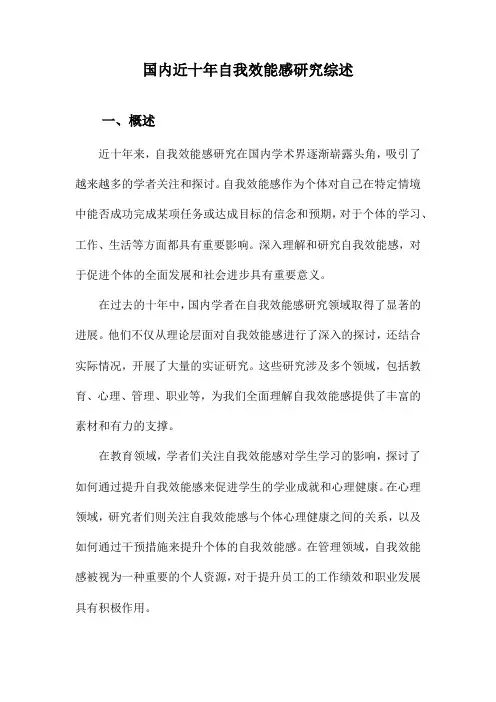
国内近十年自我效能感研究综述一、概述近十年来,自我效能感研究在国内学术界逐渐崭露头角,吸引了越来越多的学者关注和探讨。
自我效能感作为个体对自己在特定情境中能否成功完成某项任务或达成目标的信念和预期,对于个体的学习、工作、生活等方面都具有重要影响。
深入理解和研究自我效能感,对于促进个体的全面发展和社会进步具有重要意义。
在过去的十年中,国内学者在自我效能感研究领域取得了显著的进展。
他们不仅从理论层面对自我效能感进行了深入的探讨,还结合实际情况,开展了大量的实证研究。
这些研究涉及多个领域,包括教育、心理、管理、职业等,为我们全面理解自我效能感提供了丰富的素材和有力的支撑。
在教育领域,学者们关注自我效能感对学生学习的影响,探讨了如何通过提升自我效能感来促进学生的学业成就和心理健康。
在心理领域,研究者们则关注自我效能感与个体心理健康之间的关系,以及如何通过干预措施来提升个体的自我效能感。
在管理领域,自我效能感被视为一种重要的个人资源,对于提升员工的工作绩效和职业发展具有积极作用。
国内学者还积极借鉴国际上的先进理念和方法,推动了自我效能感研究的不断深入。
他们采用量化研究、质化研究等多种方法,对自我效能感进行了系统的分析和探讨。
同时,他们还结合我国特有的文化和社会背景,对自我效能感进行了本土化的研究和应用。
尽管国内在自我效能感研究方面取得了不少成果,但仍存在一些问题和挑战。
例如,对于自我效能感的影响因素和形成机制尚需进一步深入研究同时,如何有效提升个体的自我效能感也是未来研究的重要方向。
我们需要在继续深入研究和探索的同时,加强跨学科的交流和合作,以推动自我效能感研究不断向前发展。
国内近十年在自我效能感研究方面取得了显著的进展和成果,但仍需继续深入探索和完善。
我们相信,随着研究的不断深入和拓展,我们将能够更好地理解和应用自我效能感,为个体的全面发展和社会进步做出更大的贡献。
1. 自我效能感的概念界定自我效能感,作为一种重要的心理学概念,自提出以来便在教育、心理、社会等多领域引起了广泛关注和研究。
文献综述应用心理学情绪调节自我效能感和情绪劳动策略对工作满意感的影响(一)工作满意度的理论基础工作满意度的定义和侧重点不同,可分为三类:情境模型、内容型理论、过程性理论。
情境模型理论认为:工作满意收到工作任务特点、组织特性以及个人特点等因素的影响。
情境现实理论和工作满意预测模型是这类理论的代表。
前者由两个情境特性和情境现实两大部分组成,情境特性包括报酬、晋升机会、工作条件、公司政策及监督指导;情境现实表现为消极和积极的两种。
该理论假设工作的总体满意感是情境特征与情境现实这两个因素的函数。
后者从员工、工作和组织特性三方向同时考虑了多因素对工作满意感和组织承诺的预测能力。
工作任务本身已能很好地预测工作满意感,员工本身特征只具有微弱预测力,组织特性对预测只起到修正作用。
该研究结果支持了传统理论视工作本身特性为决定工作满意感的主导因素的观点,并给新近的组织决定因素的研究结果提供支持。
内容型理论认为:需要的满足与价值的实现会导致工作满意度。
马斯洛的需要层次理论与赫兹伯格的双因素论是该类理论的典型。
前者将认为的需求由低到高分为生理需要、安全需要、归属与爱的需要、尊重的需要和自我实现的需要等五种。
并认为低层次的需要在一定程度的满足后,个体会追求更高层次的需,而已得满足的需求则不再对个体构成激励。
该理论的价值在于解释和预测工作满意度。
但是,该理论并未提供验证性支持。
并没有明显的证据表示人类需求可分成阶梯状排列的五类。
而赫兹伯格的双因素理论认为,工作满意与否并非或此即彼的关系。
满意的反面是未满意,不满意的反面是没有不满。
他开创性的提出了工作满意中的满意和不满意的不对称问题,提出了保健因素和激励因素的区别和联系,被大量应用到管理实践中,但它在形成过程中没有考虑人的因素,忽略了保健因子对人的激励作用,也缺乏一定的实证支持。
过程型理论认为:期望、价值观等内源性因素的影响可对工作满意进行解释。
弗鲁姆的期望理论、阿丹的公平理论、认知失调理论和认知评价理论都是这类理论的代表。
回顾与展望:我国大学生英语学习自我效能感研究综述摘要自我效能感是指人们对自己实现特定领域行为目标所需能力的信心或信念。
自我效能感是个体在特定情境中对自己能否有能力完成特定任务或实现既定目标的一种主观推测和判断,它是通过影响人们的认知过程、动机过程、情感过程和选择过程来影响行为活动的选择、目标的设定、行为的努力程度和坚持性及表现。
英语学习自我效能感对英语学习者有重要的预测作用。
本文以文献综述法从自我效能感概念、大学生英语学习自我效能感的特点及其影响因素、实证研究工具、培养策略等方面,综述了近年来我国大学生英语学习自我效能感的研究现状,并对未来研究进行展望。
关键词英语学习;大学生;自我效能感;自我效能感理论;回顾;展望一、引言随着经济全球化的到来,中国的教育也将遇到更多的发展机会和严峻的挑战。
英语作为人们交流的工具在全球经济中扮演着重要的角色,在英语学习领域,学生在学习的过程中会受到多种内在或外在因素的影响,其中最重要的一个内在因素就是学生的自我效能感。
自我效能感是影响学生学习的一个重要的动机性情感因素,它不但会影响到学生学习目标的设定、努力的付出程度,还会影响学习策略的选择。
此外,大学阶段是个体迅速成长与成熟的关键时期,自我效能感的水平与大学生的学习、生活、就业,以及恋爱婚姻乃至身心健康都有着密切的联系。
因此,英语学习自我效能感作为效能感在英语学习领域的体现,可以理解为学生对自己是否能够成功地学习好英语的主观判断。
本文着重从我国近年来对大学生这一特殊群体的英语学习自我效能感的研究成果入手,揭示研究现状、探究研究工具、分析研究成果以及未来研究展望。
二、自我效能感及相关研究自我效能感是Bandura,A.于1997年在《自我效能:关于行为变化的综合理论》中最早提出的提出的概念,班杜拉提出自我效能感概念后,自我效能感也便成为心理学和社会学中一个重要研究领域,其后,在大量实验研究基础上,班杜拉及其同事进一步完善了这一概念,提出自我效能感理论。
情绪自我效能感研究综述摘要:情绪调节自我效能感是个体能否有效调节自身情绪状态的一种自信程度,对个体发展具有重要作用。
从情绪调节自我效能感的结构、作用机制、发展特点、影响因素等方面进行梳理,并对有关情绪调节自我效能的干预及培养进行展望。
关键词: 情绪调节自我效能感;作用机制;发展特点;影响因素;干预及培养一、情绪自我效能感概念Bandura(1986)认为,自我效能感是一个与能力有关的概念,指的是个体应付或处理环境事件的效验或有效性。
作为自我的一个方面,它是指个体以自身为对象的思维的一种形式,是个体对自己能否在一定层面上完成某一活动所具有的能力判断、信念或主体自我把握与感受。
Schultz(1990)认为,自我效能感是是个体在面临某一活动任务时的胜任感及自信、自重与自尊等方面的感受。
情绪调节自我效能感(Regulatory Emotional Self-Efficacy)概念最早由意大利心理学家caprara 等人提出。
Caprara等人(1999)认为个体在管理日常情绪体验方面存在较大差异,其原因不仅在于个体的管理技巧和能力,还在于不同个体对调节自我情绪的能力干上有很大差异,即情绪调节自我效能感上的差异。
Bandura等人(2003)同样强调个体管理情绪生活的能力感,他们认为个体具有自我情绪调节技巧是一回事,在不同的场合中能够坚持运用这些技巧是另外一回事。
情绪调节自我效能感是指个体对能否有效调节自身情绪状态的一种自信程度(Bandura,caprara等,2003)。
情绪调节自我效能是个体对自身情绪的形成、保持、回避和抑制能力的评价及对内部情绪调控的信心/信念(Caprara, Alessandri&Eisenberg, 2012)。
二、情绪调节自我效能感的结构、作用机制1.情绪调节自我效能感的结构与测量Watson &Tellegen(1985)认为,情绪调节自我效能感分为两个维度:感受正性情绪的自我效能感(perceived self-efficacy in expressing positive affect , POS)和调节负性情绪的自我效能感(perceived self-efficacy in managing negative affect , NEG)。
《中学生自我效能感对课堂参与的影响》文献综述一、前言自我效能感理论对于自我控制和调节具有重要作用。
本文阐述了自我效能感理论的界定、影响、形成因素以及自我效能感在教育学习领域最新进展,包括对学生学业成绩的影响、对学生成就动机的影响以及对教师教学行为与教师自身信念的影响。
通过对自我效能感理论在我国教育教学领域的现状分析,可以看出我国相关研究取得的成就以及不足之处,本文力求以新的视角来深入对该理论的探索运用,取得一定的创新与发展。
二、自我效能界定、影响及其形成因素1.自我效能感的界定“自我效能感”这一理论最早是由班杜拉1977年首次提出的。
班杜拉将其界定为为个体对自己能否在一定水平上完成某一活动所具有的能力判断、信念或主体自我把握与感受。
此外,其他学者对于“自我效能感”也有不同的界定,如:“是使得个体能够有效地同周围世界打交道的一种人格”、“是个人对自己能否进行某一行为的实施能力的推测或判断,它意味着人是否确信自己能够成功的进行带来某一结果的行为。
(周国涛、戚立夫)”等。
虽然不同的学者对于自我效能感的界定不同,但是其核心思想是一致的。
2.自我效能感的影响自我效能感对个体的行为具有多方面的影响。
其影响主要表现在四个方面:(1)决定人们对活动的选择及对该活动的坚持性。
即具有不同自我效能感的个体对活动的选择具有不同的偏好方向,并且对于同一活动,自我效能感不同的个体对活动的坚持能力不同。
(2)影响人们在困难面前的态度。
一般来说,自我效能感低的个体容易把困难估计的比实际更大,在问题与困难面前表现出更多的担忧与畏惧,而自我效能感高的人则相反。
(3)影响人们新行为的获得和习得行为的表现。
自我效能感不同的人对新行为的获得类型、获得速度有所不同以及对于习得行为的表现方式有所不同。
(4)影响活动时的情绪。
自我效能感较高的个体在活动时情绪较高,表现的较为轻松,而自我效能感低的个体则相反。
3.自我效能感的形成因素班杜拉等人的研究指出,自我效能感的形成因素有四个方面的经验:(1)直接经验。
自我效能感研究综述及其应用一、自我效能感的形成机制自我效能感的形成受到多个因素的影响,主要包括社会认知理论、情绪调节理论、社会学习理论等。
社会认知理论认为,个体通过观察他人的行为和结果来形成对自己能力的评价。
如果一个人看到其他人成功地完成某项任务,他就会通过观察和模仿来提升自己的自我效能感。
情绪调节理论认为,情绪和情感状态对自我效能感有着重要的影响,积极的情绪和情感会提升自我效能感,而负面的情绪和情感会降低自我效能感。
社会学习理论则认为,个体在社会环境中积累经验和知识,并且通过社会交往和交流来提升自我效能感。
二、相关研究成果自我效能感的研究涉及到多个领域,例如教育、心理学、管理学、运动训练等。
在教育领域,很多研究表明,学生的自我效能感与学习成绩之间存在显著的正相关关系,即自我效能感高的学生更容易取得好成绩。
教师的自我效能感也会影响到学生的学习情绪和学习动机。
在心理学领域,自我效能感与心理健康之间存在着密切的关系,较高的自我效能感能够降低焦虑和抑郁的发生率,提高个体的生活质量。
在管理学领域,领导者的自我效能感与团队绩效之间存在着正相关关系,领导者的自我效能感能够激发员工的工作动力和创新能力。
在运动训练领域,运动员的自我效能感与运动表现之间存在显著的正相关关系,更高的自我效能感意味着更好的运动表现。
三、应用价值自我效能感的研究成果在实践中有着广泛的应用价值。
在教育领域,教师可以通过培养学生的自我效能感来提高他们的学习动机和成绩。
在心理咨询和心理治疗中,可以通过提升个体的自我效能感来改善其心理健康状况。
在管理领域,领导者可以通过提高自己和员工的自我效能感来提高团队的绩效和创新能力。
在运动训练中,教练可以通过提高运动员的自我效能感来提高其运动表现。
10年来我国大学生自我效能感研究综述一、本文概述本文旨在全面回顾和总结过去十年来我国大学生自我效能感研究的进展与成果。
自我效能感,作为个体对自身完成特定任务或达成目标的能力的信念和期待,对于大学生的学业成就、心理健康和社会适应具有重要影响。
理解并提升大学生的自我效能感,对于促进他们的全面发展具有深远意义。
过去十年,随着心理学、教育学和社会学等多学科的交叉融合,我国对大学生自我效能感的研究逐渐深入,研究领域不断拓展,研究方法也日益丰富。
本文将从研究背景、研究内容、研究方法和研究趋势四个方面,对十年来的大学生自我效能感研究进行系统的梳理和评价,以期为未来的研究提供有益的参考和启示。
在研究背景方面,本文将探讨自我效能感理论的发展历程及其在大学生群体中的应用价值。
同时,结合我国特有的社会文化环境,分析大学生自我效能感形成和发展的影响因素。
在研究内容方面,本文将重点关注大学生自我效能感的结构维度、发展特点以及与学业成绩、心理健康、社会适应等变量之间的关系。
通过对这些内容的深入研究,揭示大学生自我效能感的内在机制和外部表现。
在研究方法方面,本文将评述过去十年中采用的定量研究、定性研究以及混合研究等方法在大学生自我效能感研究中的应用情况。
同时,分析各种方法的优缺点和适用范围,为未来的研究提供方法论的指导。
在研究趋势方面,本文将展望大学生自我效能感研究的未来发展方向。
随着信息技术的快速发展和大数据时代的到来,未来的研究将更加注重跨学科融合、跨文化比较以及动态追踪研究等方面。
提升大学生自我效能感的干预措施和实践应用也将成为研究的热点和重点。
本文旨在对过去十年来我国大学生自我效能感研究的成果进行全面梳理和评价,以期为未来的研究提供有益的参考和启示。
二、自我效能感理论框架自我效能感,源于心理学家班杜拉的社会学习理论,是指个体对自己在特定情境中,是否有能力去完成某个行为的期望。
这一理论自提出以来,在教育学、心理学、社会学等多个领域得到了广泛的研究和应用。
自我效能感-文献综述《中学生自我效能感对课堂参与的影响》文献综述一、前言自我效能感理论对于自我控制和调节具有重要作用。
本文阐述了自我效能感理论的界定、影响、形成因素以及自我效能感在教育学习领域最新进展,包括对学生学业成绩的影响、对学生成就动机的影响以及对教师教学行为与教师自身信念的影响。
通过对自我效能感理论在我国教育教学领域的现状分析,可以看出我国相关研究取得的成就以及不足之处,本文力求以新的视角来深入对该理论的探索运用,取得一定的创新与发展。
二、自我效能界定、影响及其形成因素1.自我效能感的界定“自我效能感”这一理论最早是由班杜拉1977年首次提出的。
班杜拉将其界定为为个体对自己能否在一定水平上完成某一活动所具有的能力判断、信念或主体自我把握与感受。
此外,其他学者对于“自我效能感”也有不同的界定,如:“是使得个体能够有效地同周围世界打交道的一种人格”、“是个人对自己能否进行某一行为的实施能力的推测或判断,它意味着人是否确信自己能够成功的进行带来某一结果的行为。
(周国涛、戚立夫)”等。
虽然不同的学者对于自我效能感的界定不同,但是其核心思想是一致的。
2.自我效能感的影响自我效能感对个体的行为具有多方面的影响。
其影响主要表现在四个方面:(1)决定人们对活动的选择及对该活动的坚持性。
即具有不同自我效能感的个体对活动的选择具有不同的偏好方向,并且对于同一活动,自我效能感不同的个体对活动的坚持能力不同。
(2)影响人们在困难面前的态度。
一般来说,自我效能感低的个体容易把困难估计的比实际更大,在问题与困难面前表现出更多的担忧与畏惧,而自我效能感高的人则相反。
(3)影响人们新行为的获得和习得行为的表现。
自我效能感不同的人对新行为的获得类型、获得速度有所不同以及对于习得行为的表现方式有所不同。
(4)影响活动时的情绪。
自我效能感较高的个体在活动时情绪较高,表现的较为轻松,而自我效能感低的个体则相反。
3.自我效能感的形成因素班杜拉等人的研究指出,自我效能感的形成因素有四个方面的经验:(1)直接经验。
指个体得自以往实际从事同类工作任务的成败经验。
成功的经验往往会增加个体的自我效能感,并且不断的成功会建立起稳定的自我效能感,而失败的经验的作用则相反。
同时,人们对于行为成败的归因方式,也会影响自我效能感的评价。
(2)替代经验。
即间接经验,指个体通过观察学习示范者的的行为而获得的自我效能感。
当一个人看到与自己水平差不多的示范者取得了成功,就会增强自我效能感,反之就会降低自我效能感。
(3)言语的指导作用。
即通过他人的说服性的建议、劝告、解释来改变自我效能感。
但是,有研究指出,通过这种方式建立的自我效能感并不能持久。
(4)情绪的唤起。
班杜拉认为,高度紧张的情绪会妨碍行为操作,降低对成功的预期水准,因而使得自我效能感降低。
三、自我效能感在教育领域的研究现状目前我国对于自我效能感理论在教育教学领域的应用主要集中于学生学习动机、学习成绩、学习行为以及少部分研究教师行为、教师自我信念。
下面按研究对象对各主要研究方向进行介绍。
1.学生学业成绩学习自我效能感是自我效能感在学习领域内的表现。
学习自我效能感指个体的学业能力信念,是学习者对自己能否利用所拥有的能力或技能去完成学习任务的自信程度的评价,是个体对控制自己学习行为和学习成绩能力的一种主观判断。
学习自我效能感包括学习能力自我效能感和学习行为自我效能感两个独立的维度。
能力自我效能感是指个体对自己是否有能力完成学业,取得良好成绩和避免学业失败的评估;行为自我效能感是指学生对自己的学习行为能否达到学习目标的评估,是对自己行为结果的估计。
有研究表明:自我效能感直接影响学习成绩的,不管是学习能力自我效能感还是学习行为自我效能感。
学习能力自我效能感还可以通过影响认知策略来间接影响学业成就;另外,自我效能感在成功归因和学业成就也可起到中介的作用。
在考试焦虑和考试成绩之间也是中介作用。
2.学生学习动机自我效能感对学生的直接影响表现为已感知的自我效能影响学生的学习方法过程。
自我效能感能预测学生努力的两个尺度:作业等级和精力花费。
研究表明:自我效能感较高的学生由于学习动机较为强烈,因此他们花费在学业上的精力是对于那些自我效能感是多的,并且他们学习的动机较多的是内在的,而不是外在的。
3.学生学习行为自我监控学习行为是指个体对其从事的学习活动所进行的自我调节与控制行为。
与学习成绩有密切的关系,研究表明,自我效能感与学生的组织、评价、计划、目标设置、控制等学习自我监控行为都呈现出显著正相关。
自我效能感越强,越易采用自我监控的学习行为。
策略型学习者具有较强的自我监控学习能力,所谓策略型学习者就是指能够为自己学习活动设置明确目标,自觉地运用多种类型的知识和方法,运用执行性控制过程创建学习计划,并有效对学习进程进行监控和调节,高效完成活动任务的学习者。
学者张怀春,早在1997年从自我效能感形成的影响因素和提高对成人学习行为影响作用,探索了成人学习者自我效能感的形成过程,对促进成人参加学习有指导作用。
4.教师教学行为教师自我效能感是教师对自己的教育教学水平及影响学生行为和学习成绩的能力方面的一种主观判断和感受,是促进教师自助发展的重要的内在驱力。
教师自我效能感包括个人教学效能感和一般教学效能感两个方面,前者指教师对自身教学能力的自信,后者指教师对教育教学作用的一般信念。
有研究发现:教师的教育行为表现和教育的有效性与自我效能感的高低密切相关,高自我效能感者比低自我效能感者更能有效的解决问题。
教师的自我效能感与压力之间呈现负相关,自我效能感越高,压力越小;另外,教师的集体效能感对压力的预测性也很高,之间也是负相关关系。
关于教师自我效能感的提高,有研究表明:拥有众多、良好社会支持的教师,其个人教学效能感就高;而采用消极应对方式的个体,其教学效能感就低,反之亦然。
不仅学生要对自己获得学业成功的能力有较高的自我效能感,而且教师也应当对自己帮助学生获得成功的能力有较高的自我效能感。
某些教师的自信可能表现为集体自我效能感的形式:当学校老师相信他们作为一个团队能够对学生的生活产生显著影响时,学生自己就会有较高的自我效能感并能达到更高的学业水平。
教师对自己的课堂教学效果有较高的自我效能感时,他们就会在以下几个方面影响学生成绩:(1)这些教师更愿意去尝试那些能够更好地帮助学生学习的新的教学策略。
(2)这些教师对于学生表现会有更高的期待,并会为学生设置更高的目标。
(3)这些教师会在教学中倾注更多的心血,并坚持不懈的帮助学生学习。
5.教师自我信念教师的自我效能感体验不仅能对于提高学生的学业成绩有帮助,同时教师自我效能感作为教师主体对自身能力的一种信念与内在的心理体验,对教师自主专业发展也具有重要的作用与价值。
主要体现在:(1)对教师的专业承诺有显著影响。
自我效能感越高,教师对自己所从事的职业的认同、情感依赖和投入也越高。
具有较高的专业承诺和较高的期望与责任感的教师往往能够取得满意的工作效果与成绩。
(2)是教师产生自主工作动机的内在原动力。
因为动机的激活、维持与强化过程中,最为重要的一点就是教师对自身教育能力的信念。
一些自我效能感较强的教师对教育工作抱有积极的态度,具有强烈的自我期望与胜任感,因而其工作动机常常是促进性的、适应性的,他们倾向于为自己设定和选择富有挑战性的任务与目标,并且努力地朝着这个目标迈进,即使遇到更多的困难也会想办法克服从而坚持下去。
(3)是影响教师行为和教育效果的重要中介。
教师的自我效能感不同,会影响教师工作的开展与面对问题的的态度。
而通过教师会直接影响儿童的发展和教育的有效性。
(4)是教师身心健康的重要影响源。
自我效能感对人应付压力具有重要作用。
如果教师不能控制面临的各种压力,会直接影响其身体健康。
四、总结虽然在教育领域中对自我效能感的研究在国内外都取得了一定的成就,但还存在许多不足之处,本人认为主要有以下几个方面:1.国内现有的研究大多集中在对教育领域中学生和教师自我效能感的结构、影响因素的研究上,而对于两者之间的相互影响和作用模式的研究还比较欠缺。
2.自我效能感对学生或对教师行为的影响,以及教师自我效能感对学生的影响还应该进一步的用实验的方法来验证,这样才能更加清楚地了解自我效能感起作用的真正途径。
3.教师和学生的自我效能感的干预研究还不够。
既然知道了自我效能感对教学双方都有着重要的影响,那么该如何帮助他们在面临困难的时候提高自我效能信念、采取何种适当的方式进行辅导都还有待探讨,只有找到有效的干预方式,才能真正体现对教育领域中自我效能感研究的价值。
基于以上分析,本人认为将自我效能感理论运用于课堂参与积极性的提高,不仅有利于探讨教师学生相互影响和作用的模式,而且立足于课堂实际情境,直接指向学生课堂学习效率的提高,有较大的研究价值。
其次,国内从该视角进行的相关研究较少,该领域还有尚待开发与继续探索的价值,为建构完善自我效能感的理论体系也作出了相应努力。
参考文献:[1]童瑛,陆丽青.暗示技术在提高自我效能感中的运用.现代教育科学,2005,5:24~26.[2]王雁飞,凌文辁,朱瑜.成就目标定向、自我效能与反馈寻求行为的关系.心理科学,2004,27(1):31~33.[3]马晓冬,郭本禹.成瘾行为研究中自我效能的几种类型.心理科学,2001,24(6):744~745.[4]张萌,张积家.呈现方式、自我效能感和成就动机对FOK判断影响的研究.心理学报,2000,32(4):387~392.[5]胡桂英,许百华.初中生学习归因、学习自我效能感、学习策略和学业成就关系的研究.2002,心理科学,25(6):757~759.[6]王振宏.初中学生学业自我效能与学业成就关系研究.心理发展与教育,1999,1:39~43.[7]姜飞月,郭本禹.从个体效能到集体效能———班杜拉自我效能理论的新发展.心理科学,2002,25(1):114~115.[8]池丽萍,辛自强.大学生学习动机的测量及其与自我效能感的关系.心理发展与教育,2006,2:64~70.[9]魏源.大学生学习自我效能感的测量与干预研究.心理科学,2004,27(4):905~908.[10]付梅,葛明贵,桑青松.大学生一般自我效能感与社交焦虑.中国心理卫生杂志,2005,19(7):477~478.[11]王才康,何智雯.父母养育方式和中学生自我效能感、情绪智力的关系研究.中国心理卫生杂志,2002,16(11):781~783.[12]李红.关于自我效能感与儿童社会化的研究.教育探索,2000,12:47.[13]王洪礼,胡寒春.贵州省高师本科大学生学业自我效能感与心理健康水平的研究.心理科学,2005,28(3):675~677.[14]姜英杰.国外自我效能研究中的分歧及对元认知研究的启示.东北师大学报(哲学社会科学版),2001,3:109~114.[15]程乐华,潘燕华.合作学习中一般自我效能感与自我监控的表现.心理科学,2004,25):1139~1142.[16]李宏利.计算机使用中的自我效能感.心理科学进展,2004,12(4):561~566.[17]庞丽娟,洪秀敏.教师自我效能感:教师自主发展的重要内在动力机制.教师教育研究2005,17(4):43~46.[18]艾娟,郑涛,尚晓丽.教师自我效能、集体效能与教师压力状况的关系研究.山东师范大学学报(人文社会科学版),2005,50(4):154~15[19]田宝,郭德俊.考试自我效能感是考试焦虑影响考试成绩的中介变量.心理科学,2004,22):340~343.[20]李凌.两种取向的自我效能感评估概述.心理科学,2001,24(5):618~619.[21]巩汝训,李英杰.论学生自我效能感的培养.当代教育科学,2004,5:48~49.[22]高申春.论自我效能感的主体作用机制.外国教育研究,1998,6:1~5.[23]孟慧,SteveJeong,范津砚,祝靖媛,肖承丽.目标定向的因素结构及其与自我效能感、目标设置和绩效关系的初步研究.心理科学2003,26(1):165~167.[24]黄喜珊,王才康.社会支持、应对方式与教师效能感相关分析.中国心理卫生杂志2004,18(12):857.[25]张志杰.时间管理倾向与自尊、自我效能、学习满意度;中介作用分析.心理科学2005,28(3):566~568.[26]曾荣侠,李新旺.试论自我效能感对学生学业成就的影响.教育研究与实验,2003,453~55.[27]付桂芳.提高中学生自我效能感的途径探讨.现代教育科学,2004,3:6~8.[28]任云霞. 大学生自我效能感对课堂互动的影响[J]. 长春教育学院学报,2008,02:47-49.[29]曹仕燕. 课堂互动中的大学生自我效能感培养探析[J]. 四川职业技术学院学报,2011,04:70-72.[30]李莉,白云阁,徐少冈,王耘. 教师课堂教学行为与学生课堂参与的关系——基于问卷调查的心理学实证研究[J]. 教学研究,2010,05:13-16.[31]刘萍. 大学生自我效能感与英语学习自主性的关系及促进对策研究[J]. 外语电化教学,2014,04:75-79.[32]赵燕. 焦虑与自我效能感关联性对英语学习的启示[J]. 湖北函授大学学报,2015,24:158-159.[34]邵思源. 教师自我效能感研究综述:概念、理论视角与研究主题[J]. 考试与评价(大学英语教研版),2016,02:21-26.[35]汪琴. 情感因素、课堂参与及英语学习效果研究[J]. 牡丹江大学学报,2009,05:141-144.[36]崔诣晨. 大学生自我效能感与课堂互动教学关系的实验研究[J]. 中国健康心理学杂志,2012,09:1400-1401.[37]陈俊华. 论自我效能感在学生课堂参与中的作用[J]. 中国水运(理论版),2006,02:234-235.。